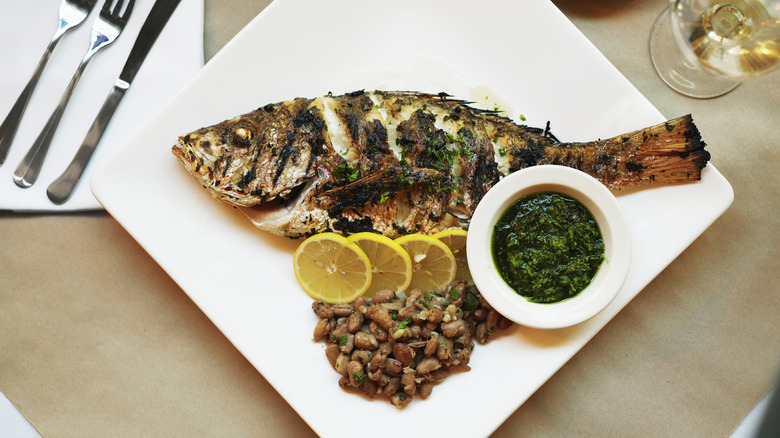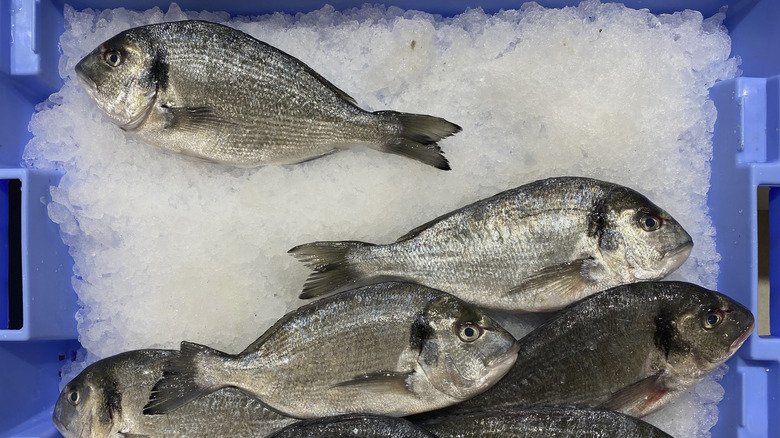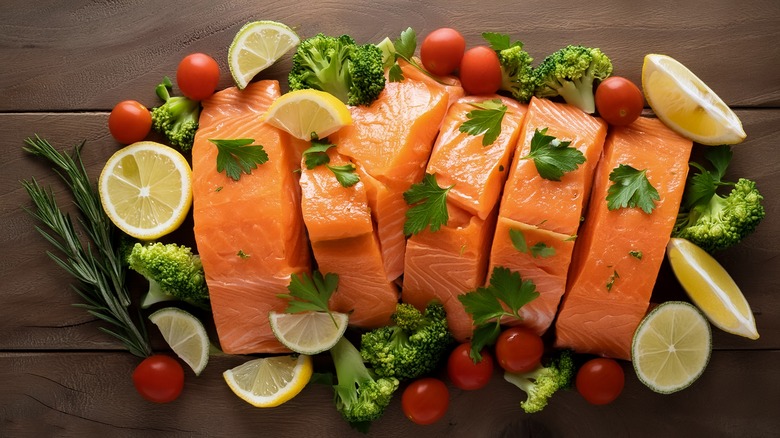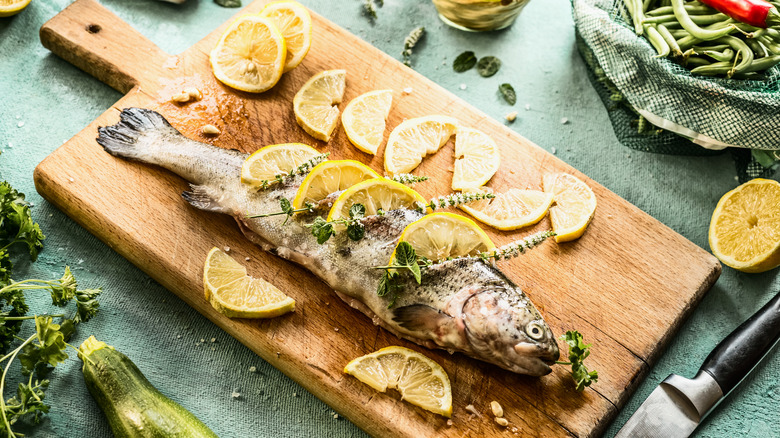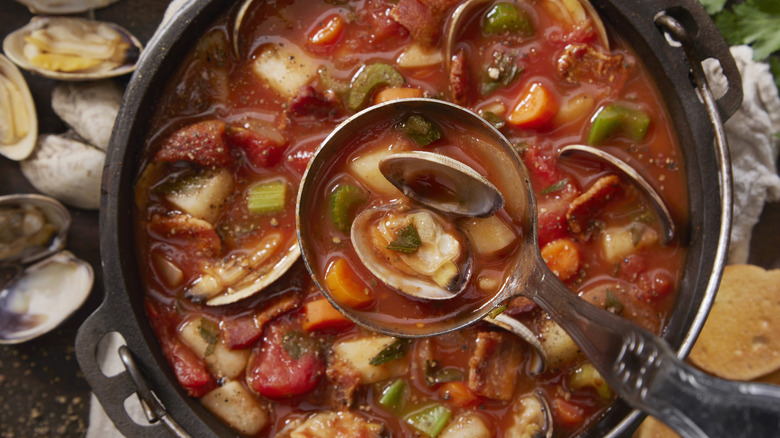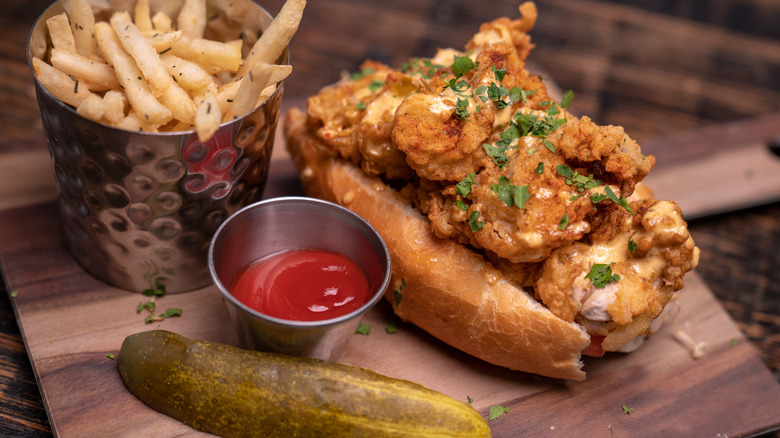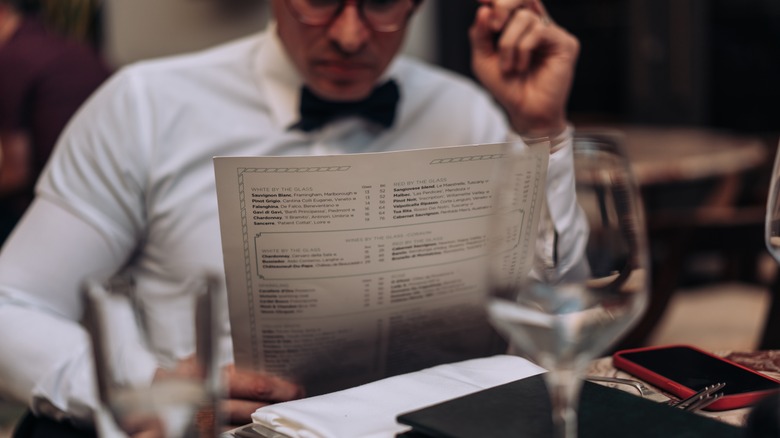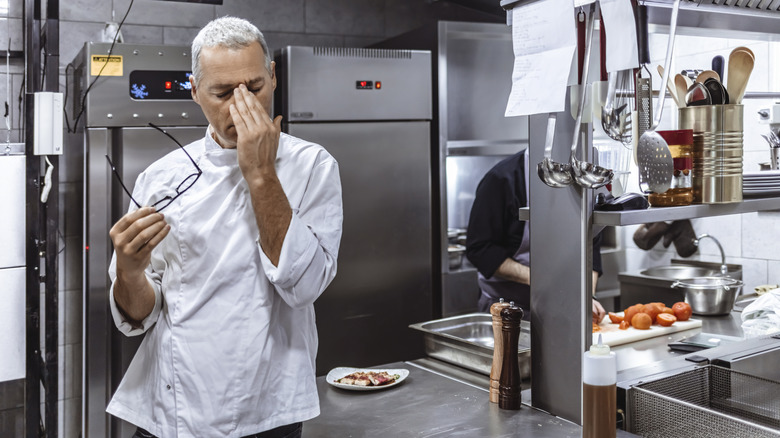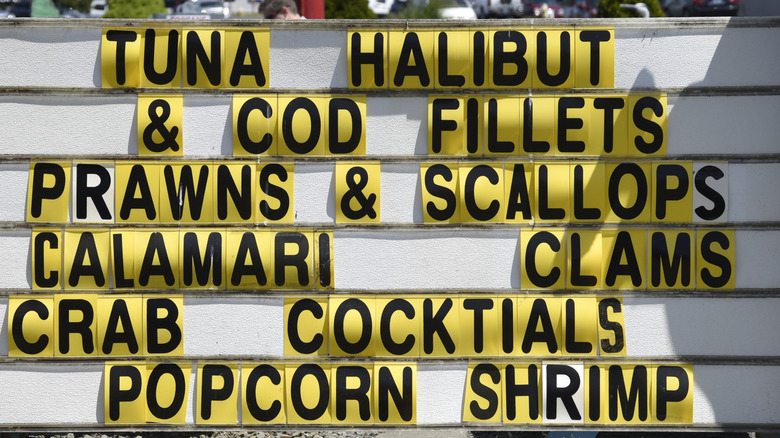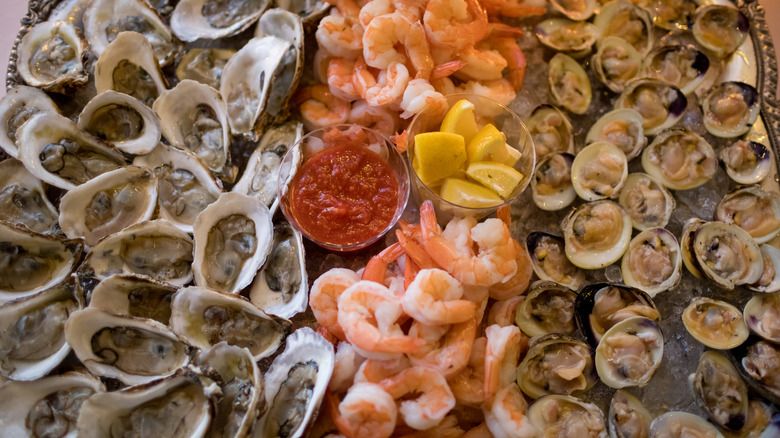What Seafood Restaurants Don't Want You To Know
Going out to a restaurant is pretty straightforward: you get seated, order, have a hopefully fantastic meal, and pay your bill. The behind the scenes looks quite different, though, and you may not want to know some of the unseen happenings in relation to seafood restaurants. The establishments themselves certainly would prefer customers stay in the dark when it comes to some of their practices (or lack thereof) and the seafood they carry.
I worked in the restaurant industry for over seven years. I've been in and out of kitchens in fine-dining country club restaurants, rowdy biker bars, and a lot of places in between. There are quite a few things that people who have never worked in the industry don't know about restaurants. Seafood restaurants in particular have some industry secrets they'd rather customers not be privy to.
If you enjoy eating out at seafood restaurants and don't wish for your next experience to be clouded by newfound knowledge, feel free to stop reading here. However, these points should help you identify which seafood spots are worth venturing into and what to look out for when scouring the menu for something to eat. From the freshness of the seafood and how specials are created to the less than savory truth of seafood buffets, here are some things that seafood restaurants would really rather you didn't know.
Fresh can really mean frozen
When you're dining out at a seafood restaurant, you expect fresh ingredients. Seafood is best right out of the ocean, right? Well, when you see "fresh" on the menu or marketing signs, it may not mean what you think it does. "Fresh" could actually mean frozen when it was fresh. While this seems like an outright lie, if seafood is flash frozen directly after being caught, it can still technically be called fresh even if it has been sitting in a freezer.
"Fresh" frozen seafood isn't just taken to a factory to be filleted and then frozen, though. They're actually flash frozen very quickly after being caught, sometimes right on the fishing ship itself! While you may think you'd prefer traditional fresh seafood, flash freezing actually kills off a lot of bacteria and parasites that would otherwise be a health risk.
If you were still hoping for daily deliveries of fish that's still kicking, I'm sorry to disappoint. Unless the chef heads down to the fish market every morning Anthony Bourdain-style, seafood restaurants typically get their seafood delivered with the rest of their food shipments. This more times than not falls to once a week — so be thankful that seafood is flash frozen.
Not all salmon is naturally orange or pink
Salmon is the most popular fish and second most popular seafood eaten in the U.S. It's beloved for its vitamin-packed nutrition and not-so-fishy taste, as well as recognized for its orangish pink (or, salmon) colored meat. That iconic coloring is (nearly) a lie, though.
Much like the flamingo, salmon isn't actually naturally pink. The hue we know and love on salmon comes from the krill they eat in their natural habitat. The issue here is that most salmon eaten isn't actually caught in its natural habitat, but farmed. Farm-raised salmon are given a dietary supplement called astaxanthin to give the fish the same color they'd take on in nature. Without astaxanthin, farm-raised salmon would be white or gray, which oddly enough is much less appetizing even considering its the color most other fish are rocking.
While this is an odd fact and one that could turn some guests off of ordering salmon, it's actually not that big of a deal. Astaxanthin is actually the same nutrient that wild salmon are consuming in the krill they eat, and it's important for their normal diet. Seafood restaurants aren't exactly shouting this tidbit from the rooftops, but you don't have to be weirded out now that you know the salmon on your plate has likely been given pink inducing supplements.
What you're eating may not be ethically sound
How much thought do you give the food you're ordering at restaurants? Beyond the price, taste, and nutrition, probably not all that much. The ethical sourcing of your meal is pretty heavy table conversation, but ignorance isn't quite as blissful when you're chewing on bad business. The truth is that quite a lot of seafood we consume comes from overfishing and foreign ships where labor comes at great costs.
According to the New Yorker, the source of quite a lot of our seafood for consumption is caught by Chinese fishing ships. On board these ships are a massive amount of workers that work hard and live in even harder conditions. Workers are lured onto ships with the promise of prosperity and essentially held hostage for longer than their agreed to contract. Seafood consumption isn't just a human rights issue, but an environmental one as well. Overfishing has seen certain species of fish become near extinct. Repercussions of the seafood industry on our environment is still relatively unknown to most casual diners, and restaurants aren't broadcasting the possible questionable ethics of their menus. Unless you are fully informed on where the seafood on a menu comes from, the ethics of how it was acquired could very well be called into question.
Those lemons you're squeezing on your fish are bacteria breeding grounds
I worked in restaurants for almost a decade, and you'll never see me order a water with lemon. Lemons are not sanitary. They're touched by almost everyone on the staff, from the person who took them from the walk-in freezer to the server whose side work it was to cut them. Then, most servers take lemons from the same large container. This means that many fingers have fished through the lemons to top off your drink with a wedge. The same goes for lemons prepped for plate placement or, even worse, placement directly on your fish. I doubt you're dining out to chow down on tilapia topped with citrus infused bacteria.
Bacteria is, in fact, very alive and well on a good amount of cut lemons. Generally, people don't consider washing citrus fruit because the peel is not consumed. When that dirty peel finds itself submerged in a drink or atop a slab of fish, though, potentially sickness-causing issues arise.
Another concern over the lemons is how they're stored for service. Lemons are meant to sit atop an ice bath and the ice bath is supposed to be changed regularly. Throughout the day and night, how many restaurants do you think keep up with their lemon ice? That's right, less than you'd feel good about. I've also seen my fair share of cut lemons aged past their prime, and I wouldn't wish that soggy mess on anyone.
The soup of the day is probably unsold seafood stock
There's not much I love more than a good soup. It's not just the versatility and heartwarming nature of the staple dish that I love, either. Soups are some of the handiest dishes to ever come out of a kitchen, as you can throw whatever you have at it and call it a solid meal. It may or may not come as a surprise that, yes, restaurants do this too. Sometimes "soup du jour" is just a fancy name for "whatever's leftover from last night's service."
If there's stock that didn't sell well or was over ordered and just needs to be used up, the soup of the day is a kitchen's knight in shining armor. Don't be too concerned, though, chef's aren't just dumping old seafood scraps in a pot and serving it up. Usually they do try to get creative, dress it up, and put together a tasty bisque or chowder that'll have you smacking your lips. There is nothing wrong with using overflow or leftover ingredients for a makeshift dish — it's actually ethically sound and a great use of resources. Just don't expect that fish stew to make the permanent menu.
Specials can be more of a second chance for excess seafood
Chopping it up and throwing it in a stew isn't the only way to get rid of excess seafood stock. If a chef has more of a certain seafood than they planned on, a great way to use it up is to put a fresh spin on it. Getting creative with specials is one of the fastest ways to push an item, especially if the wait staff is on board with vocalizing the special to each of their tables. I've worked in country clubs where chefs have created a new soft shell crab special until sold out, as well as pubs where kitchen staff have fun emptying out the pantry to make an oyster po' boy special.
Of course, restaurants don't want customers to know that the daily special is actually a last ditch effort to turn a profit and minimize waste. The term "special" can be a clever marketing tactic. Not only does it imply that there is a ticking time clock on a dish's availability, but who doesn't want to feel "special" when having a nice dinner out? Restaurants aren't broadcasting the fact that the dishes serve them, but that doesn't necessarily mean that you should never order the special at a seafood restaurant. Just be forewarned and scope out the restaurant for other potential red flags.
Being closer to the coast doesn't mean the seafood is more fresh
The smells of seafood and salty ocean water are in the air near the coast. Fisherman and crab trappers can be seen hauling in their catch of the day and fish markets are plenty. Unfortunately, this doesn't mean that walking into a coastal seafood restaurant for a meal will result in any fresher food than one closer inland. This may not sound logical, but the truth is that importing frozen seafood rather than patronizing local fish and seafood markets could help keep costs and/or labor down.
Seafood restaurants want to market fresh and local seafood. If you don't see the location of the catch on the menu or posted in the restaurant, the chances of the fish being local is very slim. On the other hand, a surefire way to tell if a seafood restaurant is good quality is to look for a local catch on their menu. The easiest way to know if you're getting freshly caught seafood at the coast is to go to the fish markets or the coast and buy your own fish straight from the source. You'll have to cook it up yourself, but there will be no confusion concerning where your seafood came from.
Menu items at a seafood restaurant may be misrepresented
Weirdly enough, menus can lie. It's true that the whole point of a menu is to explain a restaurant's offerings to customers so they'll know what they're ordering and will be happy with their choice. However, some seafood restaurants may use the menu to deceive their customers into thinking they're ordering something more quality or trendy than they actually are.
Seafood restaurants with a lower price tag on their menu items may advertise a dish as one thing, but the contents may indeed be something else or have more filler. It's not just seedy joints that bait and switch, because high dollar dishes can be guilty too. For example, tilapia has been found to be disguised as red snapper. You'd pay more thinking you were getting red snapper, only to be served tilapia, which is easier to source.
In a lot of cases, this misrepresentation happens at the base level and isn't really the restaurant's fault. Seafood fraud happens with suppliers and is a federally investigated crime. Unless you really know your seafood, it's a very real possibility that a seafood menu is disingenuous.
Some kitchens may not believe in your allergy
Before we get into the nitty gritty, I want to make it clear that most kitchens and service workers take allergies very seriously. No one wants their customers to puff up or stop breathing, and a call to 911 really puts a dent in dinner service.
It is not abnormal for a customer who claims they have a shellfish allergy to be totally fine ordering their beloved shrimp infused hush puppies. In these cases, I've personally always insisted I can't serve a customer something they've told me they're allergic to, no matter how upset they get over it. I've never stabbed anyone with an EpiPen and don't plan on ruining that streak anytime soon. However, some restaurant workers do scoff at a lot of allergy requests, especially seafood related allergies within a seafood restaurant.
Most kitchens will go to great lengths to cater to a specified allergy, but those with severe seafood allergies should probably stay out of seafood restaurants in general. Even if they prepare the food especially for the person with the allergy, staff are likely grumbling about the not insignificant effort it takes to deliver a meal with no cross contamination.
Cheap prices are a big red flag
Everyone loves a deal, but there are some things that you just shouldn't skimp out on, and seafood is one of them. The siren call of a corner store seafood platter or a fried clam basket from your local pub can be hard to resist, but a seafood deal could mean more than just a full belly and wallet.
In an exclusive Q&A interview with Mashed, executive chef Kory Foltz revealed a low price is one of the biggest red flags when ordering at seafood restaurants. A suspiciously low price could mean you're not getting what you think you're ordering, but it could also mean a low quality product. "There are exceptions to the rule but I look at pricing carefully," Foltz says. "If pricing is too low or not what you would expect then it could be lesser quality products, inferior products, or an issue with truth in the menu."
Despite what some budget seafood restaurants may want you to think, quality seafood has a cost and you're not going to find an easy loophole around it. When it comes to seafood, steering clear of the too-good-to-be-true deals are going to save you some lackluster meals, and maybe even some stomach pain.
Seafood buffets have more dangers than you may think
Buffets can be grosser than you ever knew and when combined with seafood, you really do have quite a few reasons why you should scout it out before plunging your fork and crackers into that all-you-can-eat crab leg buffet (one thing you should avoid at a buffet). First, freshness should be a priority. We've already talked a bit about how the term fresh may not mean what you think it does, but buffet fresh takes on a whole new meaning. Not only do you have to worry about how fresh the ingredients are in general, but you should also be concerned about how long the cooked food has sat around on the buffet.
According to the FDA, two hours is the general rule of thumb when it comes to swapping out food in most cases. Cold items, like a shrimp cocktail, any chilled sauces, or oysters on the half shell, should be chilled in an ice bath that is refreshed every two hours as well. If food safety isn't taken seriously here, a lot of people could get sick.
The ick factor of a seafood buffet could go beyond the food. Just like the food, utensils should be swapped out regularly. Countless hands have used each individual utensil, some of which are coming back for seconds after having eaten. Keep a look out for staff members tidying up the buffet setup and replacing serving utensils down the line.
